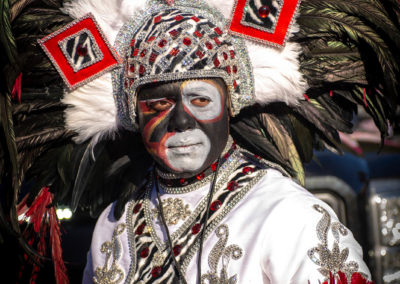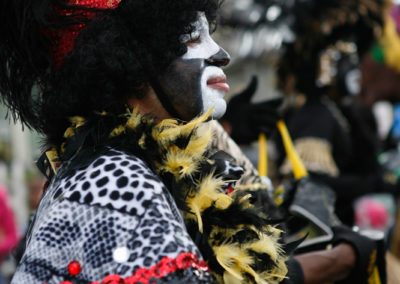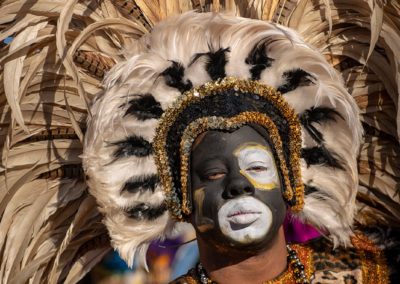With a style all its own, the Zulu Social Aid and Pleasure Club early on dispensed with scripted decorum in favor of freewheeling irreverence expressed through a parody of stereotypes of Blacks in minstrelsy traditions, wacky takes on an African jungle theme, and playing with the conventions and trappings of official (white) Carnival. The club has gained fame for its flamboyant characters and decorated coconut throws, attracted controversy for its face paint, and become a favorite mainstay of Mardi Gras.
Carnival Big Shots
Feeling the Mardi Gras spirit in 2010, when Zulu celebrated its 100th anniversary
Face paint and coconuts are rooted in the club’s humble beginnings, when members couldn’t afford trinkets to throw or masks to wear.
Photo by Lisa DuBois
A predominately African American krewe that has evolved from humble beginnings as a small, informal marching group into a popular and iconic mainstay of New Orleans Carnival, the Zulu Social Aid and Pleasure Club is famous for its raucous parades, coconut throws, facial makeup and colorful assemblage of characters.
Zulu first paraded in 1909 as the Tramps, a raggedly lot who affected the manner of hobos on Mardi Gras. The king, William Story, wore a lard-can crown and carried a banana stalk as a scepter. Sometime between 1912 and 1914, according to a historical account from the 2009 Louisiana State Museum exhibit entitled From Tramps to Kings: 100 Years of Zulu, members adopted an African theme after having seen a musical comedy that included a skit about the legendary king of the African Zulus, Shaka. The characters wore grass skirts and appeared in blackface, a common practice in vaudeville theater. The braggadocio implied by the title of the performance, “There Never Was and Never will be Another King Like Me,” helped shape the club’s identity, and to this day zany flamboyance and irreverent theatricality are essential to its style, at least as far as its Carnival activities are concerned.
Although Zulu came to be seen as an outlet for satirizing elitist pretensions in the white community’s staging of Carnival, that was never its raison d’état. The organization incorporated in 1916 with a social mission and purpose around fellowship and mutual aid, including “prompt attention to its sick and burial of its dead.” In 1949, Louis Armstrong attracted international attention when he became Carnival’s first celebrity monarch, reigning as King Zulu.
The club fell on hard times during the civil rights era, its membership dwindling to around 15 diehards by 1965, as criticisms and calls for boycotts took their toll. The Zulus’ wacky takes on African jungle life and ongoing appropriation and parody of minstrelsy traditions were seen as demeaning and out of step with the times.
Nevertheless, the krewe hung on and kept parading. Efforts to rebuild membership and status received a major boost in 1969, when the city granted the club permission to parade on Canal Street, a public space historically reserved for Rex (King of Carnival) and other white parades.
The makeup worn by members would continue to spark bouts of controversy, however, like in 2019 after it came to light that Virginia Governor Ralph Northam had appeared in a racist yearbook photo. In defending the club’s steadfast determination to maintain its makeup tradition, Zulu Historian Emeritus Clarence Becknell has pointed out that it was never intended to signify or serve as a rhetorical device for making commentary. The reason it was adopted in the first place was simply because the club’s original members couldn’t afford masks.
In contrast to the masks worn by float riders in other parades, the face paint of the Zulus does not disguise facial expression. “The fact that we mask differently gives us more energy. You can see the personality of the members,” Dr. Myron Moorehead II told New Orleans magazine in 1999 — the year he reigned as King Zulu. “I rode [in] Bacchus one year, and when you put the mask on, you lose the personal contact with the people in the crowds. By painting our faces, we lose identity, but we don’t lose the charisma. You can see the smiles and you can see the energy and you can see the expressions on the faces.”
Zulu photos by Lisa DuBois




